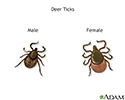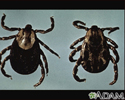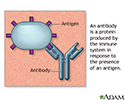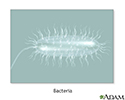Tularemia
Deerfly fever; Rabbit fever; Pahvant Valley plague; Ohara disease; Yato-byo (Japan); Lemming fever
Tularemia is a bacterial infection in wild rodents. The bacteria are passed to humans through contact with tissue from the infected animal. The bacteria can also be passed by ticks, biting flies, and mosquitoes.
Causes
Tularemia is caused by the bacterium Francisella tularensis.
Humans can get the disease through:
- A bite from an infected tick, horsefly, or mosquito
- Breathing in infected dirt or plant material
- Direct contact, through a break in the skin, with an infected animal or its dead body (most often a rabbit, muskrat, beaver, or squirrel)
- Eating infected meat (rare)
The disorder most commonly occurs in North America and parts of Europe and Asia. In the United States, this disease is found more often in Missouri, South Dakota, Oklahoma, and Arkansas. Although outbreaks can occur in the United States, they are rare.
Some people may develop pneumonia after breathing in infected dirt or plant material. This infection has been known to occur on Martha's Vineyard (Massachusetts), where bacteria are present in rabbits, raccoons, and skunks.
Symptoms
Symptoms develop 3 to 5 days after exposure. The illness usually starts suddenly. It may continue for several weeks after symptoms begin.
Symptoms include:
- Fever, chills, sweating
- Eye irritation (called conjunctivitis, if the infection began in the eye)
- Headache
- Joint stiffness, muscle pain
- Red spot on the skin, growing to become a sore (ulcer)
- Shortness of breath
- Weight loss
Exams and Tests
Tests for the condition include:
- Blood culture for the bacteria
- Blood test measuring the body's immune response (antibodies) to the infection (serology for tularemia)
- Chest x-ray
- Polymerase chain reaction (PCR) test of a sample from an ulcer
Treatment
The goal of treatment is to cure the infection with antibiotics.
The antibiotics streptomycin and tetracycline are commonly used to treat this infection. Another antibiotic, gentamicin, has been tried as an alternative to streptomycin. Gentamicin seems to be very effective, but it has been studied in only a small number of people because this is a rare disease. The antibiotics tetracycline and chloramphenicol can be used alone but are not usually a first choice.
Outlook (Prognosis)
Tularemia is fatal in about 5% of untreated cases, and in less than 1% of treated cases.
Possible Complications
Tularemia may lead to these complications:
- Bone infection (osteomyelitis)
- Infection of the sac around the heart (pericarditis)
- Infection of the membranes covering the brain and spinal cord (meningitis)
- Pneumonia
When to Contact a Medical Professional
Contact your health care provider if symptoms develop after a rodent bite, tick bite, or exposure to the flesh of a wild animal.
Prevention
Preventive measures include wearing gloves when skinning or dressing wild animals and staying away from sick or dead animals.
References
Auwaerter PG, Penn RL. Francisella tularensis (tularemia). In: Bennett JE, Dolin R, Blaser MJ, eds. Mandell, Douglas, and Bennett's Principles and Practice of Infectious Diseases. 9th ed. Philadelphia, PA: Elsevier; 2020:chap 227.
Bloch KC, Schaffner W. Tularemia and other Francisella infections. In: Goldman L, Schafer AI, eds. Goldman-Cecil Medicine. 26th ed. Philadelphia, PA: Elsevier; 2020:chap 295.
Review Date: 2/11/2023
















